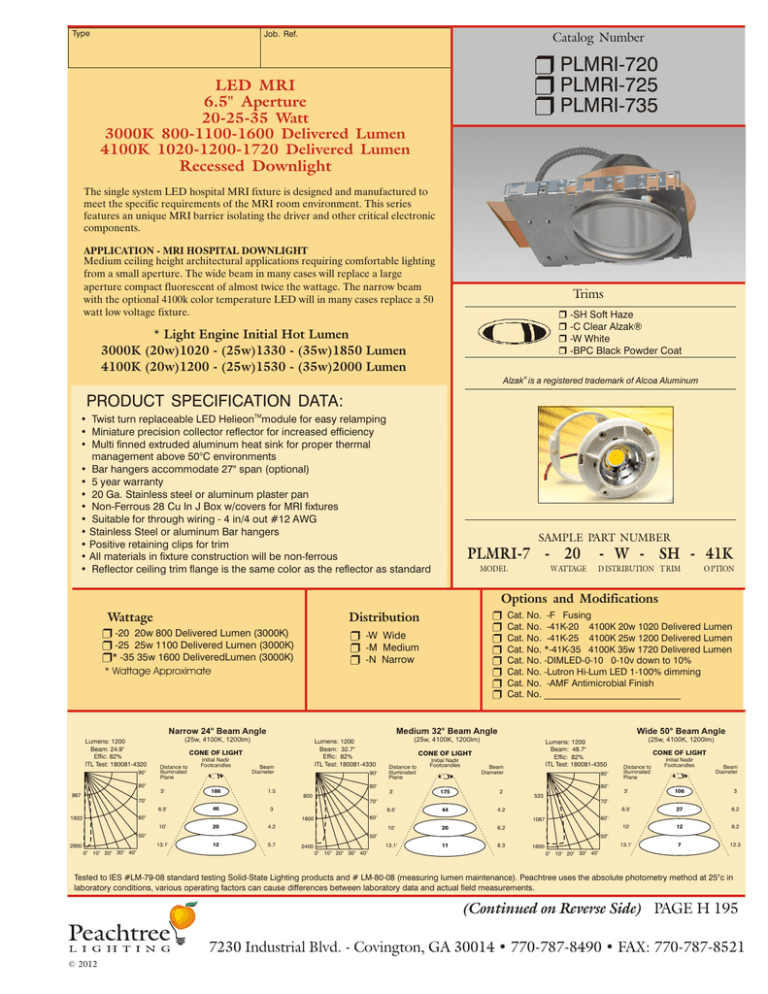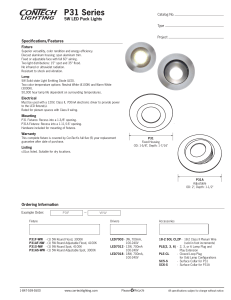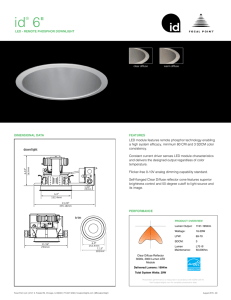plmri-720 plmri-725 plmri-735
advertisement

Type Job. Ref. Catalog Number r PLMRI-720 r PLMRI-725 r PLMRI-735 LED MRI 6.5" Aperture 20-25-35 Watt 3000K 800-1100-1600 Delivered Lumen 4100K 1020-1200-1720 Delivered Lumen Recessed Downlight The single system LED hospital MRI fixture is designed and manufactured to meet the specific requirements of the MRI room environment. This series features an unique MRI barrier isolating the driver and other critical electronic components. APPLICATION - MRI HOSPITAL DOWNLIGHT Medium ceiling height architectural applications requiring comfortable lighting from a small aperture. The wide beam in many cases will replace a large aperture compact fluorescent of almost twice the wattage. The narrow beam with the optional 4100k color temperature LED will in many cases replace a 50 watt low voltage fixture. Trims r -SH Soft Haze r -C Clear Alzak® r -W White r -BPC Black Powder Coat * Light Engine Initial Hot Lumen 3000K (20w)1020 - (25w)1330 - (35w)1850 Lumen 4100K (20w)1200 - (25w)1530 - (35w)2000 Lumen ® Alzak is a registered trademark of Alcoa Aluminum PRODUCT SPECIFICATION DATA: TM • Twist turn replaceable LED Helieon module for easy relamping • Miniature precision collector reflector for increased efficiency • Multi finned extruded aluminum heat sink for proper thermal management above 50°C environments • Bar hangers accommodate 27" span (optional) • 5 year warranty • 20 Ga. Stainless steel or aluminum plaster pan • Non-Ferrous 28 Cu In J Box w/covers for MRI fixtures • Suitable for through wiring - 4 in/4 out #12 AWG • Stainless Steel or aluminum Bar hangers • Positive retaining clips for trim • All materials in fixture construction will be non-ferrous • Reflector ceiling trim flange is the same color as the reflector as standard SAMPLE PART NUMBER PLMRI-7 - 20 MODEL WATTAGE - W - SH - 41K D ISTRIBUTION T RIM O PTION Options and Modifications Wattage r -20 20w 800 Delivered Lumen (3000K) r -25 25w 1100 Delivered Lumen (3000K) r* -35 35w 1600 DeliveredLumen (3000K) * Wattage Approximate r -W Wide r -M Medium r -N Narrow 90° (25w, 4100K, 1200lm) Lumens: 1200 Beam: 32.7° Effic: 82% ITL Test: 180081-4330 CONE OF LIGHT Distance to Illuminated Plane Initial Nadir Footcandles Beam Diameter 90° 80° 3' 967 186 1.5 70° 6.5' 46 3 10' 20 4.2 13.1' 12 5.7 0° 10° 20° 30° 40° Lumens: 1200 Beam: 48.7° Effic: 82% ITL Test: 180081-4350 CONE OF LIGHT Distance to Illuminated Plane Initial Nadir Footcandles Beam Diameter 90° 80° 800 80° 3' 175 2 6.5' 44 4.2 10' 20 6.2 13.1' 11 8.3 533 0° 10° 20° 30° 40° CONE OF LIGHT Distance to Illuminated Plane Initial Nadir Footcandles Beam Diameter 3' 106 3 6.5' 27 6.2 10' 12 9.2 13.1' 7 12.3 60° 1067 50° 2400 (25w, 4100K, 1200lm) 70° 60° 1600 50° 2900 Wide 50° Beam Angle (25w, 4100K, 1200lm) 70° 60° 1933 Cat. No. -F Fusing Cat. No. -41K-20 4100K 20w 1020 Delivered Lumen Cat. No. -41K-25 4100K 25w 1200 Delivered Lumen Cat. No. *-41K-35 4100K 35w 1720 Delivered Lumen Cat. No. -DIMLED-0-10 0-10v down to 10% Cat. No. -Lutron Hi-Lum LED 1-100% dimming Cat. No. -AMF Antimicrobial Finish Cat. No. _____________________________ Medium 32° Beam Angle Narrow 24° Beam Angle Lumens: 1200 Beam: 24.9° Effic: 82% ITL Test: 180081-4320 r r r r r r r r Distribution 50° 1600 0° 10° 20° 30° 40° Tested to IES #LM-79-08 standard testing Solid-State Lighting products and # LM-80-08 (measuring lumen maintenance). Peachtree uses the absolute photometry method at 25°c in laboratory conditions, various operating factors can cause differences between laboratory data and actual field measurements. (Continued on Reverse Side) PAGE H 195 7230 Industrial Blvd. - Covington, GA 30014 • 770-787-8490 • FAX: 770-787-8521 © 2012 LED MRI 6.5" Aperture 20-25-35 Watt 3000K 800-1100-1600 Delivered Lumen 4100K 1020-1200-1720 Delivered Lumen Recessed Downlight Catalog Number r PLMRI-720 r PLMRI-725 r PLMRI-735 Five Year limited Warranty Unlike traditional light sources, LED's do not tend to fail catastrophically. Peachtree Lighting warrants the LED module and driver assembly to be free of defects in material or workmanship for a period of three years from the date of purchase, and agrees to repair or replace at the company's option, the “failed” component. Peachtree will replace a defective element without charge for labor. This warranty does not cover labor to remove or replace the fixture back into the ceiling. This warranty excludes defects resulting from improper installation, acts of God, fire, vandalism or civil disturbances. We must be notified in writing within 60 days of component failure. An RGA must be requested and a sample must be sent to Peachtree Lighting for test and evaluation within the subsequent 30 days. The RGA request must include proof of purchase. “Failure” is considered a non-operating LED. We reserve the right to change the standard warranty period without prior written notice, without incurring obligation. THE COMPANY SHALL NOT BE LIABLE FOR INCIDENTAL, SPECIAL OR CONSEQUENTIAL DAMAGES. The semiconductor manufacturing process, like any other lamp manufacturing process, brings about variations in output to the right and to the left of mid point of the standard, regarding color and other attributes. Peachtree Lighting has investigated and considered most of all of the available procedures to control visible color shift in solid state lighting. At this time, in our opinion, “binning” (grouping similar appearing chip modules) seems to be the most consistent and reliable method. Peachtree products are color controlled using standard ANSI binning, which will be suitable for most general Architectural installations. When necessary, because of the critical color application, please contact the factory for tighter binning including a “single 3 step MacAdam ellipse”. * Luminous Flux and Delivered Lumens At the heart of most white LED's is a semiconductor chip made of nitride-based materials. The chip is positioned on top of the cathode lead. Applying volts across this device makes the chip emit blue light. Passing the light through a yellow phosphor yields white light. The LED is therefore a relatively small device emitting visible light either from the sides, bottom or both sides and bottom depending upon the very small lens and or small reflector incorporated onto the chip assembly. Calculating light output should rightly be conducted considering the whole assembly. You can not directly compare LED's and incandescent because the spectra are different. LED efficiency is measured with short burst of power. A 100% efficient incandescent would put out about 200 lumens per watt. A typical white LED is deficient in some of the longer and also shorter wavelengths to which the eye isn't very sensitive, (so the corresponding figure for a 100% efficient LED is around 325 lumens per watt) There are differences between what the eye sees and the meters read. LED's are different. IESNA has developed special LED testing methods. Peachtree Lighting data is in accordance with LM-79-08 & LM-80-08 Please use caution when comparing LED data to data from other lamp sources. 11.50 HIGH EMISSIVITY MAGNA FLUX DISSIPATER 6.375 8.75 6.50 6.75 7.75 Dimensions and specifications in this catalog are based on the most current available data and are subject to change. PAGE H 195 (Continued from Front Side) 7230 Industrial Blvd. - Covington, GA 30014 • 770-787-8490 • FAX: 770-787-8521 © 2012



